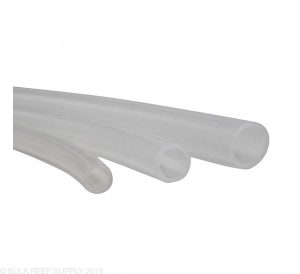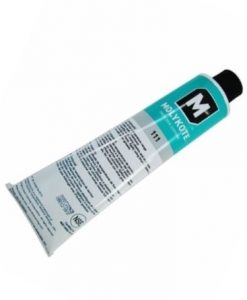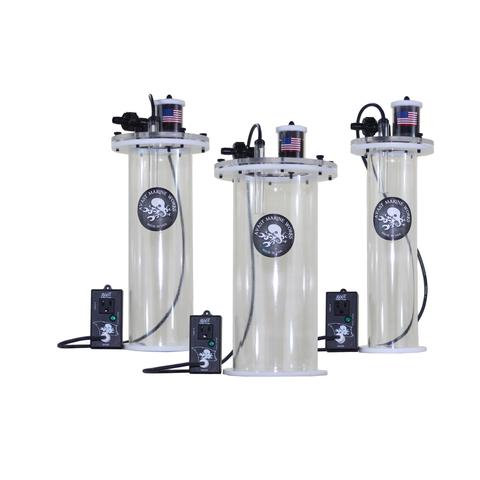
Avast Marine has been making cool equipment for quite a while now. Check out their website by clicking HERE. I love the things they make but I’m a custom installer by trade so I often need to find ways to make things work in a different manner other than a manufacturer might have intended. Sometimes it’s a valve, union or some part that could work better in a particular situation. After being around a certain piece of equipment week after week, month after month, making sure it is working optimally, you really get to know it’s virtues and/or short-comings.
DESCRIBING THE FUNCTION OF THE DAVY JONES SKIMMATE LOCKER
One of my favorite pieces of equipment from Avast is the Davy Jones skimmate locker. Click HERE to go see the line up on Avast’s website. They make four different sizes, though you might just initially notice the three (small, medium, large) ON THEIR WEBSITE. Don’t forget THE LARGE ONE that is made to be placed on a 5-7 gallon bucket. It is a skimmate collection vessel, which is a piece of equipment that has existed for a long time now, however it uses a pressure switch to cut off power to the skimmer if it gets full. You plug the pump from your skimmer into the box which also contains a pressure switch inside of it. The box itself plugs into an electrical outlet. The switch stays in the ON position unless it senses enough pressure to shut it off, shutting off the skimmer plugged into it. The skimmate locker uses a few inch long section of clear PVC 1/2″ pipe which penetrates the top of the Davy Jones and is held in place by an EPDM rubber grommet. That section of clear pipe is connected to the plug-in box via 1/4″ diameter RO tubing and is thusly connected to the pressure switch inside the box. When the level of skimmate collected inside the Davy Jones reaches the clear PVC pipe, it builds up pressure and turns the switch OFF.
This device is great for keeping your skimmer cup from overflowing and creating a giant mess under your aquarium. I would much rather have a skimmer turn off than have it sputter salty, nasty water all on the inside of my aquarium cabinetry. This can also be a fire hazard as well. It also eliminates the terrible smell associated with skimmate. This is great from a professional standpoint because my clientele is not open to rotten egg smells in their multi-million dollar houses. They even make one that is compatible with a Neptune Apex so you could have it notify your phone if it shuts off.
Having used them for several years now, I do have a couple hacks that I like to use on them for even better performance.
NOT A FAN OF THE BLACK NYLON FITTINGS

Avast uses black nylon barb fittings with a union that has never worked well for me. They tend to become difficult to unscrew over time, making physical removal of the container more difficult. What I do to remedy this is to drill out the hole in order to fit a 1/2″ bulkhead in it’s place. Then I build out the rest using regular PVC unions and fittings with a nylon barb fitting. I often get all OCD with my plumbing but I see I used a white elbow with a grey union in the picture provided. It does not matter at all but I imagine that some of you have twitchy eyes at this.
It is so much easier to deal with PVC fittings than nylon. If you are not handy with plumbing, I do realize that I do this for a living but it really is not difficult. I’d be happy to walk you through it if you need help. Comment below for specific help.
SILICONE TUBING FROM BULK REEF SUPPLY
 I love using THIS silicone tubing from Bulk Reef Supply. It is so soft and pliable that you could avoid using a union all together, as in my example above, because you can just pinch the tubing and pull it off of any barbed fitting. Normally I consider it a grave sin to use soft tubing on a barbed fitting with no clamp to secure it but this is not a high pressure situation so there is no reason to here. This type of tubing is so pliable that it grips a barbed fitting well but can still be pinched and pulled off by hand. Your call. Your comfort level.
I love using THIS silicone tubing from Bulk Reef Supply. It is so soft and pliable that you could avoid using a union all together, as in my example above, because you can just pinch the tubing and pull it off of any barbed fitting. Normally I consider it a grave sin to use soft tubing on a barbed fitting with no clamp to secure it but this is not a high pressure situation so there is no reason to here. This type of tubing is so pliable that it grips a barbed fitting well but can still be pinched and pulled off by hand. Your call. Your comfort level.
DOW 111 MOLYKOTE
 The other thing I like to do is to work a little Dow 111 Molykote o-ring lubricant onto the rubber grommet which holds the clear PVC part of the pressure switch. No need to use too much though. I use a towel to wipe up excess from the grommet before I put the clear PVC back into place. Also use it on the big O-ring between the body and the lid. You might redo this about once per year in order to keep the rubber parts pliable. This lubricant is also great for RO/DI unit o-rings, any pliable rubber parts on skimmers, even in freshwater on any rubber parts from pumps to canister filter o-rings. It is good to use this stuff on any and all rubber parts that come in contact with aquariums, freshwater or saltwater. Click HERE to check it out on Bulk Reef Supply’s website.
The other thing I like to do is to work a little Dow 111 Molykote o-ring lubricant onto the rubber grommet which holds the clear PVC part of the pressure switch. No need to use too much though. I use a towel to wipe up excess from the grommet before I put the clear PVC back into place. Also use it on the big O-ring between the body and the lid. You might redo this about once per year in order to keep the rubber parts pliable. This lubricant is also great for RO/DI unit o-rings, any pliable rubber parts on skimmers, even in freshwater on any rubber parts from pumps to canister filter o-rings. It is good to use this stuff on any and all rubber parts that come in contact with aquariums, freshwater or saltwater. Click HERE to check it out on Bulk Reef Supply’s website.
KEEP AN EYE ON THE CARBON BARREL

A great feature of the skimmate locker is that the air exits the device through a small acrylic barrel filled with activated carbon. It keeps the stench of skimmate down to pretty much non-existent. Just don’t completely ignore this carbon as eventually it won’t work as effectively at removing the smell. I noticed something recently at an account that has had a Davy Jones locker on it for 1.5 years now. On this day, the skimmer kept briefly cutting off for a fraction of a second but then coming right back on. At first I thought something was either wrong with the skimmer or the pressure switch. After observing it for a bit, I noticed that the carbon in the little barrel was soaked with water. On a hunch that this was impeding the air trying to leave the vessel, making the pressure switch think it was full, I opened up the barrel and replaced the soaked carbon. Turns out that was it. There is moist (yes, I know everyone hates that word…haha) air constantly passing through that barrel. Over time, the moisture build up could be problematic so please keep an eye on that. The carbon is super easy to change anyways. It isn’t really crucial what carbon you use to put back but I use the carbon that I like to use in all aquariums. It is sold by Kolar Labs and made by Calgon. Click HERE to check out Kolar Labs website or HERE to go straight to their carbon. Click HERE if you want to check out Calgon’s website.
If you have one of these units, hopefully my advice helps you out. If you don’t have one, I highly recommend them. Thanks so much for reading!
Ben Johnson – Captive Aquatic Ecosystems – 713-385-1297 – ben@caecosystems.com – custom aquarium installation and scheduled maintenance in Houston, Texas and beyond.


Recent Comments